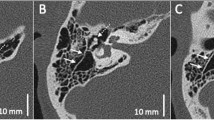Abstract
Introduction
The pneumatization of the different regions of the temporal bone is strictly related to the age and the degree of development of the mastoid and the middle ear. Petrous apex pneumatization is the last step of the development of the petrous bone system. The subcochlear canaliculus is an anatomical cavity, originating in the space between the fustis and the finiculus, and connecting the round window area to the petrous apex. The aim of the present article is analyzing the trend of development of the subcochlear canaliculus pneumatization, classified through CT scan examination, in different age subgroups.
Materials and methods
We conducted a retrospective review of patients who underwent temporal bone CT scans between 2014 and 2019. Pediatric and adult patients were included and divided into different age subgroups. The subcochlear canaliculus was examined through coronal view scans at the level of the round window niche and classified into 3 different groups (A, B and C) according to the degree of pneumatization.
Results
A total of 270 Petrous bone CT scans was analyzed. The percentage of type A subcochlear canaliculus was significantly higher in the pediatric population if compared to the adult population (p = 0.001326). As far as type B subcochlear canaliculus is concerned, the difference between children and adults was not statistically significant (p = 0.2378). On the other hand, type C subcochlear canaliculus was predominant in the adult population (p = 0.000256).
Conclusions
There is a constant increase in pneumatization of the subcochlear canaliculus from 0 to 19 years and then a progressive decrease. This discovery has relevant surgical implications and has to be borne in mind in particular for cholesteatoma surgery and cochlear implantation surgery in the age groups in which the subcochlear canaliculus is highly pneumatized.

Similar content being viewed by others
References
Canêo LF, Neirotti R (2017) The importance of the proper definition of adulthood: what is and what is not included in a scientific publication. Braz J CardiovascSurg 32:60. https://doi.org/10.21470/1678-9741-2016-0049
Cinamon U (2009) The growth rate and size of the mastoid air cell system and mastoid bone: a review and reference. Eur Arch Otorhinolaryngol 266:781–786. https://doi.org/10.1007/s00405-009-0941-8
Dexian Tan A, Ng JH, Lim SA, Low DY, Yuen HW (2018) Classification of temporal bone pneumatization on high-resolution computed tomography: prevalence patterns and implications. Otolaryngol Head Neck Surg 159:743–749. https://doi.org/10.1177/0194599818778268
Isono M, Ito A, Nakayama K, Miyashita H, Saito K, Murata K (2003) Computerized assessment of developmental changes in the mastoid air cell system. Int Congr 1254:487–491. https://doi.org/10.1016/S0531-5131(03)01061-6
Jadhav AB, Fellows D, Hand AR, Tadinada A, Lurie AG (2014) Classification and volumetric analysis of temporal bone pneumatization using cone beam computed tomography. Oral Surg Oral Med Oral Pathol Oral Radiol 117:376–384. https://doi.org/10.1016/j.oooo.2013.12.398
Lee DH, Jun BC, Kim DG, Jung MK, Yeo SW (2005) Volume variation of mastoid pneumatization in different age groups: a study by three-dimensional reconstruction based on computed tomography images. SurgRadiolAnat 27:37–42. https://doi.org/10.1007/s00276-004-0274-7
Lee DH, Kim MJ, Lee S, Choi H (2015) Anatomical factors influencing pneumatization of the petrous apex. ClinExpOtorhinolaryngol 8:339–344. https://doi.org/10.3342/ceo.2015.8.4.339
Marchioni D, Alicandri-Ciufelli M, Pothier DD, Rubini A, Presutti L (2015) The round window region and contiguous areas: endoscopic anatomy and surgical implications. Eur Arch Otorhinolaryngol 272:1103–1112. https://doi.org/10.1007/s00405-014-2923-8
Marchioni D, Soloperto D, Colleselli E, Tatti MF, Patel N, Jufas N (2016) Round window chamber and fustis: endoscopic anatomy and surgical implications. SurgRadiolAnat 38:1013–1019. https://doi.org/10.1007/s00276-016-1662-5
Nevoux J, Loundon N, Leboulanger N, Roger G, Le Pointe HD, Garabédian EN (2010) Cochlear implant in the carotid canal. Case report and literature review. Int J PediatrOtorhinolaryngol 74:701–703. https://doi.org/10.1016/j.ijporl.2010.03.005
Singh V, Krishna Chaitanya D, Chauhan BKS, Kumar IDV (2017) A comparative study of pneumatization of temporal bone. J AnatSoc India 66:78–81. https://doi.org/10.1016/j.jasi.2017.05.008
Song SW, Jun BC, Kim H, Cho Y (2017) Evaluation of temporal bone pneumatization with growth using 3D reconstructed image of computed tomography. Auris Nasus Larynx 44:522–527. https://doi.org/10.1016/j.anl.2016.11.006
Virapongse C, Sarwar M, Bhimani S, Sasaki C, Shapiro R (1985) Computed tomography of temporal bone pneumatization: 1. Normal pattern and morphology. Am J Roentgenol 145:473–481. https://doi.org/10.2214/ajr.145.3.473
Zhao P, Ding H, Lv H, Li J, Liu X, Yang Z, Wang Z (2019) Growth pattern of temporal bone pneumatization: a computed tomography study with consecutive age groups. SurgRadiolAnat 41:221–225. https://doi.org/10.1007/s00276-018-2113-2
Funding
The present authors have no financial relationship to disclose.
Author information
Authors and Affiliations
Corresponding author
Ethics declarations
Conflict of interest
All of the authors have read and approved the manuscript.
Additional information
Publisher's Note
Springer Nature remains neutral with regard to jurisdictional claims in published maps and institutional affiliations.
Rights and permissions
About this article
Cite this article
Marchioni, D., Gazzini, L., Bisi, N. et al. Subcochlear canaliculus patterns in the pediatric and adult population: radiological findings and surgical implications. Surg Radiol Anat 43, 1285–1290 (2021). https://doi.org/10.1007/s00276-021-02709-6
Received:
Accepted:
Published:
Issue Date:
DOI: https://doi.org/10.1007/s00276-021-02709-6




